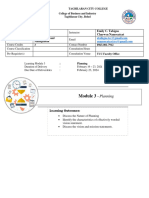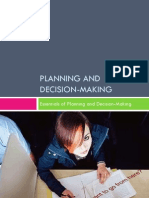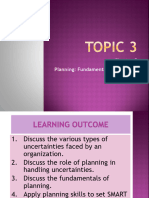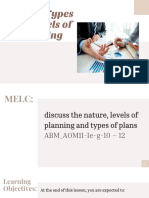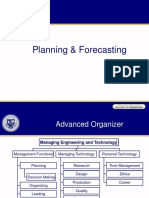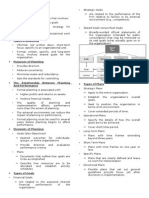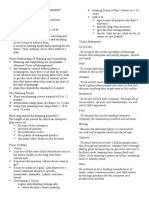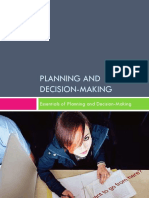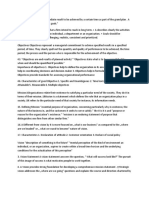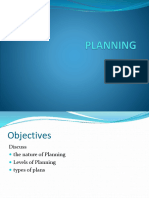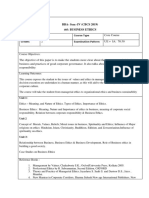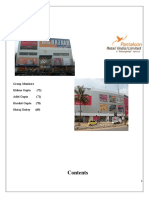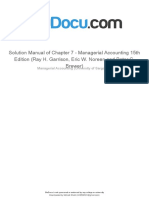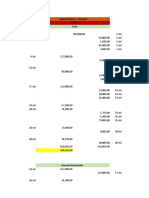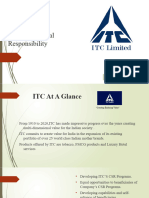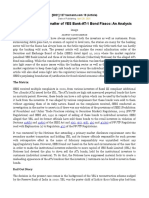Module2 - Organization and Management
Uploaded by
yangModule2 - Organization and Management
Uploaded by
yangModule 2
PLANNING
LESSON 1: IMPORTANT CONCEPTS IN PLANNING
Learning Competency: The learner is able to understand the important concepts in
planning.
Introduction of Planning
Planning- is a logical and systematic approach of formulating the objectives,
programs, policies, procedures, budgets, rules and regulations, and other
types of plans. It is considered the most basic of all managerial functions
(organizing, staffing, directing, and controlling).
The Hierarchy of Planning and other Types of Plans
Planning Hierarchy
-we can stratify planning in a hierarchy with three general levels: strategic,
tactical, and operational.
1. Strategic Planning. It is the function of top managers who are
concerned with long-run initiatives, the mission, and major objectives
to support the mission. It will include a dozen or more major objectives
guiding management decisions toward fulfilling the firm’s mission.
2. Tactical Planning. Managers at the tactical level are middle managers
who are concerned with converting strategic objectives into short-term
plans. Moreover, most managers at this level have profit and loss
responsibilities for divisions, plants, and some functional areas such as
marketing.
3. Operational Planning. This is evolved by supervisors and other
managers who regularly deal with non-management employ. This level
of planning is most concerned with budgets, quotas, and schedules,
which are further refinements of tactical objectives.
Other Types of Plans
Standing Plans - these plans serve as guidelines to managerial action.
Single-use Plans- these plans ceases to exist when the goals are
achieved.
Long-range Plans - under this plan, assumptions must be made about
uncontrollable and controllable variables.
Intermediate Plans -these plans are made for the realization of long-
range goals.
Organization and Management Module 1
IBN Siena Integrated School Foundation
Short-range Plans- these plans provide the guidelines for day-to-day
actions in the organization.
Marketing Plans- these plans has the objectives in increasing their
present market share and develop new products.
Production Plans- these focus on producing the desired amount of
goods demanded at the market place.
Financial Plans- these plans provide a quantitative basis for decision
making and control.
Manpower Plans- these involved a systematic way of determining the
types of personnel needed in the long and short-range for an organization.
Strategic Plans- it involves determining the major of the entire
organization and policies to guide the achievement of these goals.
Tactical Plans- it deals with the determination of the short term-specific
utilization of the resources of the organization in achieving its strategic
goals.
Planning Horizon: Short-Range Versus Long-Range - short-range
plans generally cover up to one year, while the long-range plans start at
the end of the current tear and extend into the future.
Functional Plans- in addition to being long-range or short-range, plans
are often classified by function or use.The most frequently encountered
types of functional plan are sales and marketing plans, production plans,
financial plans, and personnel plans.
Operational versus Strategic Plans- strategic planning is the process
which sets forth organizational objectives to be achieved, strategies and
policies needed to reach those objectives. Operational or tactical
planning is short-range planning and concentrate on the formulation of
functional plans.
Present examples of plans used by companies nowadays:
Jollibee Food Corporation, McDonalds, and Chicken Bon Chon Philippines.
➢ Marketing Plans
➢ Production Plans
GMA Network Inc. & Asia Brewery
➢ Manpower Plans
Andok’s Litson Corporation & Sandy Javier
➢ Short-rangePlans
Organization and Management Module 2
IBN Siena Integrated School Foundation
Mission, Vision, Goals, Objectives and Values
Mission
-It is the purpose or reason for the existence of an organization
a statement of the organizations purpose on what it wants to accomplish
Coca-Cola Company Mission
>> to refresh the world….
>> to inspire moments of optimism and happiness…
>> to create value and make a difference
Mission Statement:
>>Our Roadmap starts with our mission, which is enduring.
It declares our purpose as a company and serves as the standard
against which we weigh our actions and decisions.
Vision
- Is a vivid mental image of what you want your business to be at some point
in the future based on your goals and aspirations.
Coca-Cola Company Vision
>People: Be a great lace to work where people are inspired to be
the best they can be.
>Portfolio: Bring to the world a portfolio of quality beverage brands
that anticipate and satisfy people’s desires and needs.
>Partners: Nurture a winning network of customers and suppliers,
together we create mutual enduring value.
>Planet: Be a responsible citizen that makes a difference by
helping build and support sustainable communities.
>Profit: Maximize long-term return to shareowners while being
mindful of our overall responsibilities.
>Productivity: Be a highly effective, lean and fast-moving
organization.
Vision Statement:
“Our corporate vision is to become “The undisputed leader in every
market in which we compete”.
Distinguishing Mission and Vision
Mission
->> it statement on what the company is currently doing
->> it can vary from very simple to very complex
Organization and Management Module 3
IBN Siena Integrated School Foundation
Vision
->> is a statement of what the company hopes to achieve over time and this
would be very broad and specific
->> it is often more abstract and less direct than the mission
Objectives or Goals
▪ intended goal prescribed definite scope and suggest direction to maximize
the efforts of a manager
▪ it is an estimated result expected in the future
▪ it gives a sense of direction, unity and purpose
▪ play a big role in forming the foundation for companies in the decision-
making process
▪ it can be communicated through mission statement
Coca-Cola Company Objectives
--- maintain a trusted local presence in every community they serve
--- to be globally known as a business that conducts business
responsibility and ethically and to accelerate sustainable growth operate in
tomorrow’s world
Goals and Objectives Flowchart
Mission Statement
Our Roadmap starts with our mission, which is enduring. It
declares our purpose as a company and serves as a standard against
which we weigh our actions and decision. Our mission is to refresh the
world, inspire moments of optimism and happiness, and to create
value and make a difference.
Goal Goal Goal
A desire Encourages recycling of Bring a smile to the
for their their containers customers faces
products
to taste
refreshing
Increase Focus on environment Keeping customers
profit by friendly bottling production demand in mind
cutting and enforce sustainability
down cost
through
productive
and
efficient
production
facilities
Organization and Management Module 4
IBN Siena Integrated School Foundation
Values
▪ values should be at the core of every business
▪ they are what your business stands for your philosophy, your reason for
being
▪ it helps to steer your business, management and employees in the right
direction
Three step process to develop values for your business:
1. The principles you stand for personality
2. The beliefs and attitudes you and your staff have in common in the
workplace
3. Your organizations standard of behavior
Implementing Business Values
▪ Develop a draft values statement with your staff
-at least 5 core values everyone known and cares about
▪ You need to make your values an art of everything your business does.
▪ Stand for business values consistently
▪ Regularly talk about your values and test new ideas and suggestions against
how well they align to your values.
▪ Select and promote staff on their values, not just their job ability
▪ Train staff in key values
▪ Encourage staff to speak out about breaches of values
▪ Challenge people when you see them do and say things that undermine values
or raise people when they embrace values
▪ Raise values as an art of your meeting and discussions when considering
courses of actions or business decisions.
▪ Make your values visible to staff and customers
Coca- Coca Company Values
“Our values serve as a compass for our actions and describes how we
behave in this world”
-Leadership : The courage to shape a better future
-Collaboration: Working together
-Integrity: Be real
-Accountability: Responsible
-Passion: Committed in heart and mind
-Diversity: As an inclusive as our brands
-Quality: What we do, we do well
Formal Planning Process
The Ten Areas of Concern
1. Establish organizational goals within the context of a clear mission statement
Organization and Management Module 5
IBN Siena Integrated School Foundation
2. Evaluate environmental factors facing the organization from both internal and
external forces.
3. Articulate assumption about the future to reflect expectation of reasonable
performance.
4. Identify and involve management and staff at all levels for appropriate
development of objectives.
5. Develop alternatives to plans then choose the best current alternatives which are
feasible, realistic, and sufficient to support objectives.
6. Stratify plans within the organization to assure full coordination of activities at
strategic, tactical, and operational levels.
7. Communicate plans and provide documentation for appropriate delegation of
authority, control, and performance feedback.
8. Identify and develop appropriate programs, projects, and budgets for an
organizational “action plan.”
9. Implement the action plan with appropriate flexibility and check points for
adaptation.
10. Immediately begin to plan “to plan.”
The formal planning process implies a conscious effort to provide adaptability
within the organization. One cannot set a plan in motion and simply let it run its course.
As soon as the plan is in effect, it is time to investigate a new cycle of planning.
Manager’s “plan” to plan as a conscious commitment to the future of their organizations.
Planning Tools and Techniques
▪ Assessing the Environment
▪ Techniques for assessing the environment
➢ Environmental Scanning
➢ Forecasting
ENVIRONMENTAL SCANNING
➢ The screening of large amount of information to anticipate and
interpret change in the environment
▪ Competitor Intelligence
➢ The process of gathering information about competitors – who they
are? What are they doing?
▪ Global Scanning
➢ Screening a broad scope of information on global forces that might
affect the organizations.
▪ Allocating Resources
Organization and Management Module 6
IBN Siena Integrated School Foundation
TYPES OF RESOURCES
➢ Financial: debt, equity, and retained earnings.
➢ Physical: buildings, equipment, and raw materials
➢ Human: experience, skills, knowledge, and competencies
➢ Intangible: brand names, patents, reputations, trademarks, copyrights
and Databases
➢ Structural cultural: history, culture, work systems, working relationship,
trust and policies.
TOOLS FOR ALLOCATING RESOURCES
Budgets
- are numerical plans for allocating resources (e.g. , revenues,
expenses, and capital expenditures).
- are the most commonly used and most widely applicable planning
technique for organizations.
Budget Example for Small Business
SCHEDULING
- plans that allocates resources by detailing what activities have to
be done, the order in which they are to be completed, who is to do
each, and when they are to be completed.
• Network Analysis
- a quantitative technique used for scheduling
Examples of Networks
➢ PERT (Program Evaluation Review Technique)
➢ CPM (Critical Path Method)
2 basic concepts in these techniques
➢ Events
➢ Activities
3 types of timing
➢ Optimistic time – the minimum time it could take
➢ Pessimistic time – the maximum time it could take
➢ Probable time
Steps in developing a PERT Network
1. Identify and list major task in a project.
2. Determine the order in which these events must be completed.
Organization and Management Module 7
IBN Siena Integrated School Foundation
3. Diagram the flow of activities from start to finish, identify each activity and
its relationship to all other activities.
4. Compute a time estimate for completing each activity.
5. Draw a PERT network showing the sequence and time.
Adaptability and Creativity
Adaptability is even more important when time is of the essence; often there is
not enough time to research a problem or clarify company policies. There are times for
instance when safety considerations require quick decisions. At other times, managers
working in the field without access to information must make “spot” decisions.
In addition, managers seldom find that policies cover all situations. Even the
most pervasive policies cannot account for changing circumstances and unusual
situations.
Creativity
Perhaps one of the most important influences on managerial decisions
today is a growing desire to encourage creativity. However, companies also
needed innovation to grow. It was almost as if company leaders were setting dual
standards for their managers. On one hand, innovation and creativity were
essential if companies were to survive and grow, yet innovation was severely
restrained by a preoccupation with conformity.
Organization and Management Module 8
IBN Siena Integrated School Foundation
ORGANIZATION AND MANAGEMENT
Activity 2.1
Name: ______________________________________ Section: ___________ Score: _________
Format: Long, Arial Narrow, 12 font size, 1-inch margin in all sides, PDF.
Instruction. Answer the questions enumerated below based on your own understanding. Avoid copying
and pasting answers from the online sources; it can be easily detected. Never share your answer to your
classmates; similar outputs will not be given any points. Write your answer on the space provided.
1. What is planning? How important is planning for the success of an organization? Elaborate your answer.
(10pts.)
2. Discuss each of the levels of planning in your own words. Provide illustration to expound your answer.
(15pts.)
3. Assume that you will establish your own organization/company. Develop/craft the following for your own
organization:
a. Organization/Company Name (2pts.)
b. Mission (5pts.)
c. Vision (5 pts.)
d. Goals/Objectives -at least 3 goals/objectives (3pts. per goal/objective)
e. Values - at least 3 values (3pts. per values)
Organization and Management Module 9
IBN Siena Integrated School Foundation
LESSON 2: BASIC CONCEPTS IN DECISION-MAKING
Learning Competency: The learner is able to understand the basic concepts in
decision-making.
The Decision-Making Environments
Decision Making Environment
Conditions for decision making
Certainty Known Outcomes
Risk
Probabilities can be
estimated
Uncertainty Outcomes unknown without
objectives probabilities.
Certainty-Managers know outcomes under each set of alternatives
For example: choosing where to deposit or putting ones’ money in a bank
saving account.
Decision making under these certain conditions seldom requires a lengthy
process of investigation: one selects an alternatives and takes action.
Risk- when managers can calculate statistically the probabilities outcome. Most
managerial decisions are risks.
Decision maker has enough information to assign probability to the happening or
non-happening of each possible event. Information is generally based on the past
experience by managers who have faced risky decision.
Decisions are enhanced by objectively determined probabilities.
Example: Tossing a coin, there is a time that heads come up and a time that tails come
up, but one can never be certain or sure of which will come out or what will happen.
Organization and Management Module 10
IBN Siena Integrated School Foundation
In organization environment, probabilities are important for making decision
about a wide array of investment such as planning new products, entering new markets,
or estimating how many consumers behavior.
Forecasting sales, for instance, is usually based on estimating how customers
are likely to buy products at a given price for a given period of time.
An experienced manager might, for example, have a feeling about what how
competitors will react to price reduction and therefore modify the sales forecast.
Manager use their past experience and information to infer outcomes about future
events.
Uncertainty – when probabilities are unknown or possible to estimate.
Such uncertainty situations generally arise in cases where happening of the
events is determined by external factors.
For example: Demand of the product, moves of competitors, etc.
Where, Managers don’t have any idea of what possible event would come or
probabilities will happen.
This is particularly important when decisions depend on human behavior.
Behavioral Techniques in Decision Making
1. Brainstorming
Brainstorming requires freedom of expression by individuals within group with as
little structure as possible to allow the greatest degree of human interaction.
Guidelines for assuring effective brainstorming
▪ Criticism must be minimized.
▪ Limitations on the number and variety of ideas should not be stifled.
▪ Synergism should be encouraged through collaborate contributions and a
healthy competition to build on one another’s ideas.
Research has shown that brainstorming is most effective in groups of five to
seven individuals.
Organization and Management Module 11
IBN Siena Integrated School Foundation
2. Nominal Groups. A refinement of brainstorming is the nominal group. This
technique follows many of the fundamental guidelines for effective brainstorming
but allows individuals to develop ideas independently.
Nominal Group Technique
Individuals develop ideas
Ideas listed for openly for review
Discussion, clarification, evaluation
Individuals vote or rank order ideas
Poll voted results in preferences
Decision or choice made
The recognized benefits of nominal group have led to a formal method of
decision making in organizations called the nominal group technique (NGT).
The NGT has the following steps:
• Step 1: Panel members working independently develop and list ideas on a focal
issue.
• Step 2: each panel members individually queried for one idea in a “round robin”
process.
• Step 3: when all responses has been transcribe, panel members discuss, clarify,
and elaborate points.
• Step 4: individual panel members silently and privately vote on ideas either by
assigning a rank order or using a predetermined rating scale for each idea.
3. Delphi Method. The Delphi technique is a survey method of polling a panel
member on a well-defined problem. However, unlike brainstorming or nominal
group techniques, Delphi does not bring individuals together in face-to-face
meetings. Anonymity is maintained to encourage candid responses without the
sociopsychological pressures of group of interaction.
Organization and Management Module 12
IBN Siena Integrated School Foundation
Delphi Method for Decision Making
Topic defined for participants Round #1 of Delphi participants survey
Responses collected and compiled; all Round #2 of Delphi participants surveyed
returned to each participant.
Repeat collection and distribution Repeat sounds as needed for consensus
Final compilation with consensus Respondents usually informed with
future follow up if needed
Operation Research Techniques
Operation research involves the application of quantitative methods to decision
making. Operation Research (OR) has been defined by Miller and Starr as “Applied
Decision Theory” in which decision maker seeks scientific, logical or mathematical
means, observation, analysis, hypothesis formulation and experimentation are the
methods generally used in OR techniques.
1. Queuing or Waiting-line Method. This method uses mathematical techniques
for balancing waiting lines and services provided. When there is irregular
demand, waiting lines occur and the manager must decide how to handle the
situation.
2. Linear Programming. This technique is used in decisions involving the
allocation of resource or limited resources to reach a particular objective such as
least cost, highest margin and so on. When these resources have several
alternatives uses. This method is used for solving simple, complex and routine
problems. In order to apply this method, the situation must involve two or more
activities competing for limited resources and all relationships in the situation
must be linear.
3. Game theory. This involves selecting the best strategy, taking into consideration
one’s actions and the action of one’s competitors. Thus, it is a “conflict of
interest” where one individual tries to win.
4. Simulation. This technique involves the building of a model that represents a
real or an existing system. These models are useful in evaluating and selecting
the best one.
Organization and Management Module 13
IBN Siena Integrated School Foundation
5. Decision Tree. This is an interesting technique used in analyzing a decision.
Through a graphic illustration, the alternative solutions can be identified and
probability estimates are assigned to these alternatives and pay-offs relating
alternatives can be determined.
The Decision-Making Process
Step 1: Set objectives
▪ The existence of a problem implies the need for a decision
maker to make at least one decision, and typically a series of
decisions, to resolve a problem. In this first step, the decision
maker sets the objectives for the decision.
Step 2: identify constraint
▪ Constraint in some way limit the decision maker choices.
Constraints could be defined by legal, economic, or political
considerations. Decision’s constraints are sometimes presented
in terms of desired specification or performance standards.
Step 3: identify alternatives
▪ the decision-making process involves making a choice between
two or more alternatives.
▪ the decision maker identifies alternatives solutions that meet the
constraints outlined in step
Step 4: Gather appropriate information
▪ the information requirements for a given decision vary
considerably depending on the complexity and scope of the
decision to be made.
▪ the decision maker gathers information that may provide insight
as to which alternative to choose.
Step 5: evaluate alternatives
▪ the decision maker evaluates each alternative. A decision can
be rendered based on available information.
Step 6: choose the most acceptable alternatives
▪ the manager examines the ranking of alternatives and selects
the most acceptable alternative, which is often the top-ranked
alternative.
Organization and Management Module 14
IBN Siena Integrated School Foundation
Why Manager Fail in Planning
1. Lack of real commitment
▪ Despite the avowed interest in planning there is often a lack of
real commitment by managers from the top level down to low
level supervisor.
2. Interchanging planning studies with plans
▪ Nothing is planned unless include the decision of some kind.
Yet many organization and people believe they have planning
when al they have been planning studies.
3. Failure to Develop and Implement Sound Strategies
▪ Strategies are the kind of plans which give unified direction to
the enterprise, planning efforts. Without a sound strategy, which
is often the case, plans go in the wrong direction. Moreover,
unless a strategy is implemented by an action plan, it becomes
only a statement of wishes and hopes.
4. Lack of Meaningful Objectives and goals
▪ Planning cannot be effective unless goal is clear, attainable, like
supporting plans, goals must be defined in the light of strengths
and weaknesses and the many internal and external forces that
may influence their achievement.
5. Tendency to underestimate the planning premises
▪ If plans and decisions in an organization are to be consistent;
that is, to fit another, they must be implemented if a system of
planning is to be complete.
6. Failure to see the scope of plans
▪ Some managers get so wrapped up in developing major and
minor programs that they neglect to see that there are other
types of plans: missions or purposes, objectives or goals,
strategies, policies, rules, procedures and budget as well as
programs. All must involve analysis and decision making and
must be implemented if a system of planning is to be complete.
7. Failure to see a planning as rational process
▪ Planning is a practical exercise in rationalization. It requires
clear goals, a knowledge of alternatives, an ability to analyze
alternatives in the light of goals sought, information and a desire
to come up with the best possible answer.
8. Too much reliance an experience
▪ Experience as has been indicated is likely to be dangerous
teacher simply because what happened in the past may not
likely fit a future situation.
Organization and Management Module 15
IBN Siena Integrated School Foundation
9. Failure to use the principle of limiting factor
▪ It will be recalled that this principle requires managers to search
out those factors that would make the most problem situation,
there are so many variables that no one can solve for all of
them.
10. Lack of top management support
▪ Planning is not like to be very effective if top management does
not believe in it, encourage it, or make the necessary decisions
that will allow its subordinates to make their plans.
11. Lack of clear delegation
▪ It is obviously very difficult for people to plan if they do not know
what their job are, if they are unaware of how their jobs relate to
other in an organization, and if they do not have clear authority
to make decisions.
12. Lack of adequate control techniques and information.
▪ Since the task of managerial control is to follow up plans and to
assure that these are actually succeeding. Planning can hardly
be very difficult but effective unless the people responsible for
these know how well they are working.
Organization and Management Module 16
IBN Siena Integrated School Foundation
ORGANIZATION AND MANAGEMENT
Activity 2.2
Name: ______________________________________ Section: ___________ Score: _________
Format: Long, Arial Narrow, 12 font size, 1-inch margin in all sides, PDF.
Instruction. Answer the questions enumerated below based on your own understanding. Avoid copying
and pasting answers from the online sources; it can be easily detected. Never share your answer to your
classmates; similar outputs will not be given any points. Write your answer on the space provided.
1. Discuss each of the condition in decision-making (certainty, uncertainty, risk). Provide illustration to
elaborate your answer (15pts.)
2. As a future manager, illustrate/discuss how the following techniques will be used in decision-making:
a. Brainstorming (5pts.)
b. Nominal Groups (5pts.)
c. Delphi Method (5pts.)
3. Discuss each of the step in decision-making process. (3pts per step.)
4. In your own opinion, why do manager fail in planning? How could a manager avoid such reason of
failure? (7pts.)
Organization and Management Module 17
IBN Siena Integrated School Foundation
REFERENCES
Aeppel, T. (2009, April 6). As manufacturers buckle, winners emerge from havoc. Wall
Street Journal, p. B1.
Aragón-Sánchez, A., & Sánchez-Marín, G. (2005). Strategic orientation, management
characteristics, and performance: A study of Spanish SMEs. Journal of Small
Business Management, 43(3), 287–308.
Ash, M. K. (1984). Mary Kay on people management. New York: Warner Books.
Baron, R. S., & Shane, S. (2008). Growing your business: Making human resources
work for you. New York: Business Expert Press.
Barris, M. (2009, May 27). AutoZone profit rises 9.5% on solid sales. Wall Street
Journal, p. B2.
Bradford, R. W., & Duncan, J. P. (2000). Simplified strategic planning. Worcester, MA:
Chandler House Press.
Case, J. (1995). Open-book management: ...
Organization and Management Module 18
IBN Siena Integrated School Foundation
You might also like
- Management Topic 3-Chapter 5-Planning The Foundation of Successful ManagementNo ratings yetManagement Topic 3-Chapter 5-Planning The Foundation of Successful Management34 pages
- Fundamentals and Stages of Planning and Scheduling Construction WorksNo ratings yetFundamentals and Stages of Planning and Scheduling Construction Works77 pages
- Principle and Practice of Management Unit 2No ratings yetPrinciple and Practice of Management Unit 241 pages
- PMGT - FBMD - Midterms - Planning and OrganizingNo ratings yetPMGT - FBMD - Midterms - Planning and Organizing121 pages
- SM 31 Study Guide and Reading Materials Preliminary PeriodNo ratings yetSM 31 Study Guide and Reading Materials Preliminary Period33 pages
- Definition 2. How Planning Starts 3. Levels of Planning 4. Types of PlansNo ratings yetDefinition 2. How Planning Starts 3. Levels of Planning 4. Types of Plans21 pages
- Chapter 1-STRATEGIC MARKETING VS. TACTICAL MARKETINGNo ratings yetChapter 1-STRATEGIC MARKETING VS. TACTICAL MARKETING9 pages
- The Fundamentals of The Strategic Planning ProcessNo ratings yetThe Fundamentals of The Strategic Planning Process34 pages
- Learning:module:1: Trainees Manual and Information Sheet For DBA Level IV Compiled by G.D in 12/12/2007No ratings yetLearning:module:1: Trainees Manual and Information Sheet For DBA Level IV Compiled by G.D in 12/12/20077 pages
- Performance Management & Strategic PlanningNo ratings yetPerformance Management & Strategic Planning23 pages
- The Manager As A Planner and Strategist: Chapter EightNo ratings yetThe Manager As A Planner and Strategist: Chapter Eight12 pages
- Term 3 Week 1 Session: Subject: Trainer: Email:: 01 MG14 - Operational Planning Fabricio MassonNo ratings yetTerm 3 Week 1 Session: Subject: Trainer: Email:: 01 MG14 - Operational Planning Fabricio Masson42 pages
- 2 Planning and Decision-Making FunctionNo ratings yet2 Planning and Decision-Making Function89 pages
- Edutainment Show 11th Edition Kolkata Chapter - 2025 - HRC - CompressedNo ratings yetEdutainment Show 11th Edition Kolkata Chapter - 2025 - HRC - Compressed36 pages
- Led & Maintenance Factors: Revision 3, 2021No ratings yetLed & Maintenance Factors: Revision 3, 202110 pages
- 19566/uttaranchal Exp Sleeper Class (SL)No ratings yet19566/uttaranchal Exp Sleeper Class (SL)2 pages
- Group Members Kishan Gupta (72) Aditi Gupta (71) Harshit Gupta (70) Dhiraj DubeyNo ratings yetGroup Members Kishan Gupta (72) Aditi Gupta (71) Harshit Gupta (70) Dhiraj Dubey16 pages
- By: Mythili Selvam L.Preethi Nifty JacobNo ratings yetBy: Mythili Selvam L.Preethi Nifty Jacob24 pages
- Solution Manual of Chapter 7 Managerial Accounting 15th Edition Ray H Garrison Eric W Noreen and Peter C Brewer100% (1)Solution Manual of Chapter 7 Managerial Accounting 15th Edition Ray H Garrison Eric W Noreen and Peter C Brewer55 pages
- Nar 5500 Full Corporate Offer (4) @ Cif Quangzhou - 230324 - 201016No ratings yetNar 5500 Full Corporate Offer (4) @ Cif Quangzhou - 230324 - 2010166 pages
- Maynilad Quezon City 1,010,880 MayniladNo ratings yetMaynilad Quezon City 1,010,880 Maynilad14 pages
- Corporate Social Responsibility (ITC Limited)No ratings yetCorporate Social Responsibility (ITC Limited)10 pages
- Case Study-Retail Walmart Store Sales Prediction - ForecastingNo ratings yetCase Study-Retail Walmart Store Sales Prediction - Forecasting3 pages
- SEBI's Order in The Matter of YES Bank-AT-1 Bond Fiasco: An AnalysisNo ratings yetSEBI's Order in The Matter of YES Bank-AT-1 Bond Fiasco: An Analysis3 pages


